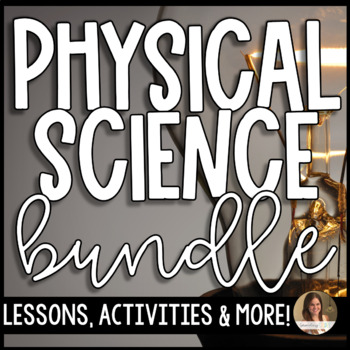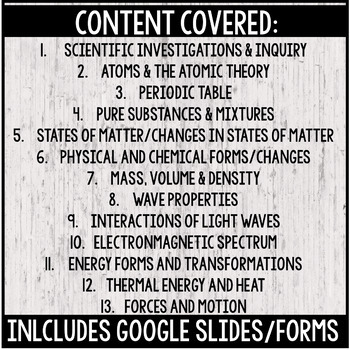Physical Science Year Long Curriculum Bundle - Lessons, Activities & More!
- Zip
- Google Apps™

What educators are saying
Products in this Bundle (89)
showing 1-5 of 89 products
Bonus
Description
Save over 20% with this resource that includes all of my physical science activities including PowerPoints, Guided Notes, Assessments, Warm Ups, Self-Grading Task Cards, Choice Boards, Interactive science notebook Google Slides and Print Activities, Labs, Stations activities, project-based learning , exit tickets and more! Most of these resources are editable and include google slides or google forms options!
*** This is a growing bundle! Each time a new activity is added, the price will increase. After purchasing, you will have access to any added physical science activity at NO cost! ***
-----------------------------------------------------------------------------------------------------------------------
TOPICS COVERED:
1. Scientific investigations and Inquiry
Content covered:
⭐ Experiments vs Observations
⭐ Creating a Hypothesis
⭐ Variables (Independent, Dependent, Constant)
⭐ Data (qualitative vs quantitative)
⭐ Scientific Method Steps
⭐ Repetition vs. Replication
2. Mass, Volume and Density
Content covered:
⭐ Matter
⭐ Mass
⭐ Weight
⭐ Volume
⭐ Formulas as well as calculating mass, volume and density
⭐ Water displacement
3. Physical and Chemical Changes
Content covered:
⭐ Physical properties (mass, weight, volume, density, malleability, thermal conductivity, electrical conductivity, solubility, magnetism, luster, viscosity)
⭐ Chemical Properties (reactivity, flammability)
⭐ Physical changes
⭐ Chemical Changes
⭐ Law of Conservation of Mass
4. Energy Forms and Transformations
Content covered:
⭐What is energy?
⭐Types of Potential Energy
⭐Types of Kinetic Energy
⭐Energy Transformations
⭐Law of Conservation of Energy
5. Thermal Energy and Heat
Content covered:
⭐ Thermal Energy
⭐ Temperature
⭐ Heat
⭐ Conduction
⭐ Convection
⭐ Radiation
6. Forces and Motion
Content covered:
⭐Motion
⭐Speed
⭐Calculating Average Speed
⭐Velocity
⭐Acceleration
⭐Balanced & Unbalanced Forces
⭐Contact Forces
⭐Forces at a Distance
⭐Newton's Laws of Motion.
➾Graphing velocity, average speed or acceleration is not included.
7. Pure Substances and Mixtures
Content covered:
⭐ Pure substances
⭐ Elements
⭐ Compounds
⭐ Mixtures (heterogeneous, homogeneous)
⭐ Solutions, colloids and suspensions
8. Atoms and the Atomic Theory
Content covered:
⭐ Atoms
⭐ Atomic Structure and subatomic particle masses
⭐Contributing scientists to the atomic theory (Democritus, Aristotle, John Dalton, J.J. Thomson, Ernest Rutherford, Erwin Schrödinger and Werner Heisenburg)
⭐ Isotopes
⭐ Atomic number
⭐ Mass number
9. Changes in States of Matter
Content covered:
⭐ States of matter (solid, liquid, gas)
⭐ Kinetic Theory of Matter
⭐ Thermal Energy
⭐ Changes in states of matter (Boiling, evaporation, condensation, melting, freezing, vaporization, sublimation, deposition)
⭐ Pressure and Temperature
10. Periodic Table
Content covered:
⭐ What is the Periodic Table?
⭐ How to obtain information from the periodic table.
⭐ Dimitri Mendeleev and Henry Mosely.
⭐ Chemical name, chemical symbol, atomic number, average atomic mass.
⭐ Groups and periods.
⭐ Metals, nonmetals and metalloids.
⭐ Arrangement of elements.
⭐ How to determine if elements have similar properties.
11. Interactions of Light Waves
Content covered:
⭐ Transparent, translucent and opaque
⭐ Reflection, refraction and absorption
⭐ Brief explanation of prisms
⭐ Wavelengths of color
⭐ How can we see color?
12. Properties of Waves
Content covered:
⭐ What is a wave?
⭐ Transverse and longitudinal waves
⭐ Mechanical vs. electromagnetic waves
⭐ Parts of transverse waves
⭐ Parts of longitudinal waves
⭐ Wavelength
⭐ Amplitude
⭐ Frequency
13. Electromagnetic Spectrum
Content covered:
⭐ What is electromagnetic radiation?
⭐ What is the electromagnetic spectrum?
⭐ Radio waves
⭐ Microwaves
⭐ Infrared
⭐ Visible Light
⭐ What determines the color of light?
⭐ Ultraviolet
⭐ X-rays
⭐ Gamma Rays
⭐ what role does the sun play?





